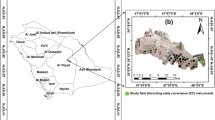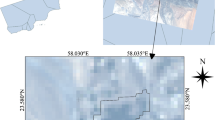Abstract
This study applied a time series evapotranspiration (ET) data derived from the remote sensing to evaluate Soil and Water Assessment Tool (SWAT) model calibration, which is a unique method. The SWAT hydrologic model utilized monthly stream flow data from two US Geological Survey (USGS) stations within the Big Sunflower River Watershed (BSRW) in Northwestern, Mississippi. Surface energy balance algorithm for land (SEBAL), which utilized MODerate Resolution Imaging Spectro-radiometer (MODIS) to generate monthly ET time series data images were evaluated with the SWAT model. The SWAT hydrological model was calibrated and validated using monthly stream flow data with the default, flow only, ET only, and flow-ET modeling scenarios. The flow only and ET only modeling scenarios showed equally good model performances with the coefficient of determination (R2) and Nash Sutcliffe Efficiency (NSE) from 0.71 to 0.86 followed by flow-ET only scenario with the R2 and NSE from 0.66 to 0.83, and default scenario with R2 and NSE from 0.39 to 0.78 during model calibration and validation at Merigold and Sunflower gage stations within the watershed. The SWAT model over-predicted ET when compared with the Modis-based ET. The ET-based ET had the closest ET prediction (~8% over-prediction) as followed by flow-ET-based ET (~16%), default-based ET (~27%) and flow-based ET (~47%). The ET-based modeling scenario demonstrated consistently good model performance on streamflow and ET simulation in this study. The results of this study demonstrated use of Modis-based remote sensing data to evaluate the SWAT model streamflow and ET calibration and validation, which can be applied in watersheds with the lack of meteorological data.






Similar content being viewed by others
References
Abbaspour KC, Yang J, Maximov I, Siber R, Bogner K, Mieleitner J, Zobrist J, Srinivasan R (2007) Modeling hydrology and water quality in the pre-alpine/alpine Thur watershed using SWAT. J Hydrol 333:413–430
Arnold JG, Srinivasan P, Muttiah RS, Williams JR (1998) Large area hydrologic modeling and assessment. Part I. Model development. J Am Water Resour Assoc 34:73–89
Asner GP, Lobell DB (2000) A biogeophysical approach for automated SWIR un-mixing of soils and vegetation. Remote Sens Environ 74:99–112
Bastiaanssen WGM, Menenti M, Feddes RA, Holtslag AM (1998) A remote sensing surface energy balance algorithm for land (SEBAL)-formulation. J Hydrol 212–213:198–212
Bowman AL, Franz KJ, Hogue TS, Kinoshita AM (2015) MODIS-Based Potential Evapotranspiration Demand Curves for the Sacramento Soil Moisture Accounting Model. J Hydrol Eng 21(1):04015055–1-13
Broxton PD, Zeng X, Scheftic W, Peter AT (2014) A MODIS-based global 1-km maximum green vegetation fraction dataset. Am Meteorol Soc 53:1996–2004
Cho KH, Pachepsky YA, Kim JH, Kim JW, Park MH (2012) The modified SWAT model for predicting fecal coliforms in the Wachusett reservoir watershed, USA. Water Res 46(15):4750–4760
Christensen NS, Wood AW, Voisin N, Lettenmaier DP, Palmer RN (2004) The effects of climate change on the hydrology and water resources of the Colorado River basin. Clim Chang 62:337–363
Daggupati P, Pai N, Ale S, Douglas-Mankin KR, Zeckoski R, Jeong J, Parajuli PB, Saraswat D, Youssef MA (2015) A recommended calibration and validation strategy for hydrologic and water quality models. Trans Am Soc Agric Biol Eng 58(6):1705–1719
Dakhlalla AO, Parajuli PB (2016) Evaluation of the best management practices at the watershed scale to attenuate peak streamflow under climate change scenarios. Water Resour Manag 30(3):963–982
Dakhlalla AO, Parajuli PB, Ouyang Y, Schmitz DW (2016) Evaluating the impacts of crop rotations on groundwater storage and recharge in an agricultural watershed. Agric Water Manag 163:332–343
Delta Agricultural Weather Center (DAWC) (2012) Delta research and extension center, Mississippi State University, Stoneville. Available at: http://www.deltaweather.msstate.edu/. Accessed 5 Jan 2015
Doherty J. (2005) PEST: model independent parameter estimation 5th ed. Brisbane: watermark numerical Computing
Drexler J, Snyder R, Spano D (2004) A review of models and micrometeorological methods used to estimate wetland evapotranspiration. Hydrol Process 18(11):2071–2101
Ficklin D, Luo Y, Luedeling E, Zhang M (2009) Climate change sensitivity assessment of a highly agricultural watershed using SWAT. J Hydrol 374(1–2):16–29
Gamage N, Smakhtin V, Perera BJC (2011) Estimation of actual evapotranspiration using remote Sensing data. 19th International congress on modelling and simulation, Perth, Australia, 12–16 December 2011
Gao Y (2008) Intercomparison of remote sensing-based models for estimation of evapotranspiration and accuracy assessment based on SWAT. Hydrol Process 22(25):4850–4869
Hanson RL (1991) Evapotranspiration and droughts, in Paulson, RW, chase, EB, Roberts, RS, and moody, DW, compilers, National Water Summary 1988-89--hydrologic events and floods and droughts: U.S. Geol Surv Water-Supply Paper 2375:99–104
Hunt GE, Kandel R, Mecherikunnel AT (1986) A history of presatellite investigations of the earth’s radiation budget. Rev Geophys 24:351–356
Hussey B, Odum W (1992) Evapotranspiration in tidal marshes. Estuar Coasts 15(1):59–67
Immerzeel WW, Droogers P (2008) Calibration of a distributed hydrological model based on satellite evapotranspiration. J Hydrol 349(3–4):411–424
Justice CO, Townshend JRG, Vermote EF, Masuoka E, Wolfe RE, Saleous N, Roy DP, Morisette JT (2002) An overview of MODIS land data processing and product status. Remote Sens Environ 83:3–15
Kannan N, White S, Worrall F, Whelan M (2007) Sensitivity analysis and identification of the best evapotranspiration and runoff options for hydrological modelling in SWAT-2000. J Hydrol 332(3–4):456–466
Kiehl JT, Trenberth KE (1997) Earth’s annual global mean energy budget. Bull Am Meteorol Soc 78:197–208
Kim HK, Parajuli PB (2014) Impacts of reservoir outflow estimation methods in SWAT model calibration. Trans Am Soc Agric Biol Eng 57(4):1029–1042
Kim HK, Parajuli PB, Filip SD (2013) Assessing impacts of bioenergy crops and climate change on hydrometeorology in the Yazoo River basin, Mississippi. Agric For Meteorol 169:61–73
Korzun VI, Budyko MI, Sokolov AA, Voskresensky KP, Konoplyantsev AA, Kalinin GP (1978) Atlas of world water balance. USSR National Committee for the international hydrological decade. English translation. UNESCO, Paris
L’vovich MI, White GF (1990) Use and transformation of terrestrial water systems. In: Turner BL, Clark WC, Kates RW, Richards JF, Mathews JT, Meyer WB (eds) The Earth as Transformed by Human Action. Cambridge University Press, Cambridge, pp 235–252
Lirong S, Jianyun Z (2012) Hydrological response to climate change in Beijiang River basin based on the SWAT model. Procedia Eng 28:241–245
Lopez-Urrea R, Martin de Santa Olalla F, Fabeiro C, Moratalla A (2006) Testing evapotranspiration equations using lysimeter observations in a semiarid climate. Agric Water Manag 85(1–2):15–26
Los SO, Collatz GJ, Sellers PJ, Malmstroem CM, Pollack NH, DeFries RS, Bounoua L, Parris MT, Tucker CJ, Dazlich DA (2000) A global 9-year biophysical land surface data set from NOAA AVHRR data. J Hydrometeorol 1:183–199
Lucht W, Prentice IC, Myneni RB, Sitch S, Friedlingstein P, Cramer W, Bousquet P, Buermann W, Smith B (2002) Climatic control of the high-latitude vegetation greening trend and Pinatubo effect. Science 296:1687–1689
Masih I, Maskey S, Uhlenbrook S, Smakhtin V (2011) Impact of upstream changes in rain-fed agriculture on downstream flow in a semi-arid basin. Agric Water Manag 100(1):36–45
Moriasi DN, Arnold JG, Van Liew MW, Bingner RL, Harmel RD, Veith TL, Van Liew M (2007) Model evaluation guidelines for systematic quantification of accuracy in watershed simulations. Trans Am Soc Agric Biol Eng 50(3): 885–900
Moriasi DN, Gitau MW, Pai N, Daggupati P (2015) Hydrologic and water quality models: performance measures and evaluation criteria. Trans Am Soc Agric Biol Eng 58(6):1763–1785
Mu Q, Maosheng Z, Steven WR (2011) Improvements to a MODIS global terrestrial evapotranspiration algorithm. Remote Sens Environ 115:1781–1800
National Agricultural Statistics Service (NASS) (2013) Quick stats: agricultural statistics database. Washington, DC. Available at: http://www.nass.usda.gov/Quick_Stats/. Accessed 5 Jan 2015
National Climatic Data Center (NCDC) (2013) Climate Data Online. Available at: http://www.ncdc.noaa.gov/cdo-web. Accessed 15 Jan 2015
Neitsch SL, Arnold JG, Kiniry JR, Williams JR (2011) Soil and water assessment tool (SWAT), theoretical documentation, version 2009. Blackland Research Center: Temple
Overgaard J, Rosbjerg D, Butts M (2006) Land-surface modelling in hydrological perspective: a review. Biogeosciences 3(2):229–241
Parajuli PB (2010) Assessing sensitivity of hydrologic responses to climate change from forested watershed in Mississippi. Hydrol Process 24(26):3785–3797
Parajuli PB, Jayakody P, Sassenrath GF, Ouyang Y, Pote JW (2013) Assessing the impacts of crop rotation and tillage on crop yields and sediment yield using a modeling approach. Agric Water Manag 119:32–42
Parajuli PB, Jayakody P, Sassenrath GF, Ouyang Y (2016) Assessing the impacts of climate change and tillage practices on stream flow, crop and sediment yields from the Mississippi River basin. Agric Water Manag 168:112–124
Parasuraman K, Elshorbagy A, Carey S (2007) Modelling the dynamics of the evapotranspiration process using genetic programming. Hydrol Sci J 52(3):563–578
Parmesan C, Yohe G (2003) A globally coherent fingerprint of climate change impacts across natural systems. Nature 421:37–42
Payne JT, Wood AW, Hamlet AF, Palmer RN, Lettenmaier DP (2003) Mitigating the effects of climate change on the water resources of the Columbia River basin. Clim Chang 62(1–3):233–256
Pisinaras V, Petalas C, Gikas GD, Gemitzi A, Tsihrintzis VA (2010) Hydrological and water quality modeling in a medium-sized basin using the soil and water assessment tool (SWAT). Desalination 250(1):274–286
Potter C, Peggy G, Steven K, Matthew F, Vanessa G (2008) Storage of carbon in U.S. forests predicted from satellite data, ecosystem modeling, and inventory summaries. Clim Chang 90:269–282
Rosenberg NJ, Brown RA, Izaurralde RC, Thomson AM (2003) Integrated assessment of Hadley Centre (HadCM2) climate change projections on agricultural productivity and irrigation water supply in the conterminous United States. Part I: climate change scenarios and impacts on irrigation water supply simulated with the HUMUS model. Agric For Meteorol 117(1–2):73–96
Shrestha RR, Dibike YB, Prowse TD (2012) Modelling of climate-induced hydrologic changes in the Lake Winnipeg watershed. J Great Lakes Res 38(3):83–94
Stone MC, Hotchkiss RH, Hubbard CM, Fontaine TA, Mearns LO, Arnold JG (2001) Impacts of climate change on Missouri River basin water yield. J Am Water Resour Assoc 37(5):1119–1130
Tang R, Xia J, Zhang X, Yin X (2007) MODIS-based estimates of the regional evapotranspiration. Remote sensing for environmental monitoring and change detection. Proceedings of symposium HS3007 at IUGG2007, Perugia, July 2007. IAHS Publ 316, 2007
Thampi SG, Kolladi YR, Surya TV (2010) Influence of scale on SWAT model calibration for streamflow in a River Basin in the humid tropics. Water Resour Manag 24:4567–4578
U.S. Department of Agriculture (USDA) (2005) U.S. General soil map: Natural Resources Conservation Services. Available at: http://soildatamart.nrcs.usda.gov. Accessed 15 Jan 2013
U.S. Department of Agriculture, National Agricultural Statistic Services (USDA_NASS) (2009) Cropland data layer: Available at: http://www.nass.usda.gov. Accessed 15 Jan 2013
U.S. Geological Survey (USGS) (2010) National Elevation Dataset (NED): Available at: http://seamless.usgs.gov/ned1.php. Accessed 15 Jan 2013
Venturini V, Islam S, Rodriguez L (2007) Estimation of evaporative fraction and evapotranspiration from MODIS products using a complementary based model. Remote Sens Environ 112:132–141
Yuan Y, Khare Y, Wang X, Parajuli PB, Kisekka I, Finsterle S (2015) Hydrologic and water quality models: sensitivity. Trans Am Soc Agric Biol Eng 58(6):1721–1744
Zhang B, Kang S, Li F, Zhang L (2008) Comparison of three evapotranspiration models to Bowen ratio-energy balance method for a vineyard in an arid desert region of northwest China. Agric For Meteorol 148(10):1629–1640
Zhou L, Zhou G (2009) Measurement and modelling of evapotranspiration over a reed (Phragmites Australis) marsh in Northeast China. J Hydrol 372(1–4):41–47
Acknowledgements
We would like to acknowledge the partial financial support of AFRI competitive grant award # 2013-67020-21407 and 2017-67020-26375, from the USDA/NIFA; and Special Research Initiatives of the Mississippi Agricultural and Forestry Experiment Station at Mississippi State University. We would like to acknowledge the support of Yazoo Mississippi Delta Joint Water Management District; USGS; and all our collaborators.
Author information
Authors and Affiliations
Corresponding author
Rights and permissions
About this article
Cite this article
Parajuli, P.B., Jayakody, P. & Ouyang, Y. Evaluation of Using Remote Sensing Evapotranspiration Data in SWAT. Water Resour Manage 32, 985–996 (2018). https://doi.org/10.1007/s11269-017-1850-z
Received:
Accepted:
Published:
Issue Date:
DOI: https://doi.org/10.1007/s11269-017-1850-z




